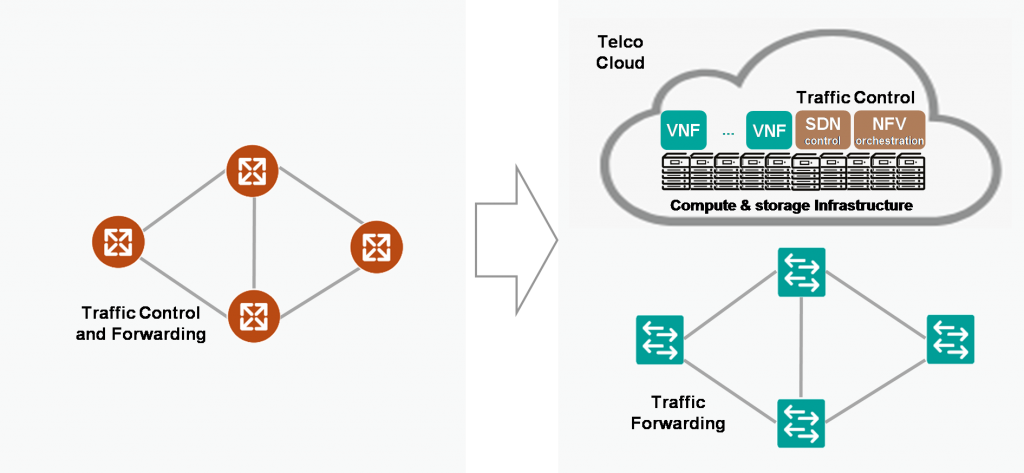Today’s telecom networks are composed of hundreds of distinct network elements including routers, switches, firewalls and optical multiplexers. These functions have long been built as dedicated physical appliances with custom, tightly coupled hardware and software components. Service providers have deployed multiple generations of these “closed systems” over the years, creating several layers of technologies and various bridges to enable interoperability between them.
The main drawbacks of this technology paradigm are that it creates operational complexity, forces lock in to vendor platforms, does not keep up with the expected unit cost decline and slows down innovation due to its lack of flexibility to develop new services. Over the last decades the telco industry has been stuck with me-too product capabilities forcing service providers to differentiate on pricing or customer experience only.
Software Defined Networking (SDN) and Network Function Virtualization (NFV) promise to break this paradigm and put operators and customers in control of their networks and services.
The essence of SDN and NFV is as follows:
- Redesigning existing closed network elements into software functions running on commodity cloud computing server infrastructure (NFV)
- Separating and centralising the network control software from the network traffic forwarding function (SDN)
- Enabling real-time service provisioning and network optimisation through software programmability (orchestration)

The new network has a lower cost structure from a capital and operating perspective, thanks to the adoption of commodity hardware and open software and to a much greater degree of operational automation. More importantly, the network has better capabilities to architect and create new services, thanks to the flexibility and the openness of software based network functions.
The centralised SDN control function gives service providers and customers the capability to create and consume services in an on demand fashion.
The separation of Virtual Network Functions (VNFs) from the underlying hardware enables the creation of a service ecosystem where new service components (e.g. virtual routers, virtual firewalls, WAN optimisation functions) can be developed and integrated more easily and can be chained together to create a more sophisticated service logic.
This service ecosystem is open to different actors, not only the mainstream telecom platform manufacturers but also independent software vendors and the service provider itself. End customers are also the big winners in this ecosystem, being able to play a role in the service creation, mixing virtual service components from different sources within their own environment to define business capabilities in a flexible way.
This approach enables the creation of new business models, with the network becoming an open platform enabling a service marketplace.
The availability of large amounts of data related to customer service usage and to network health parameters originating from different sources in the network can be leveraged to enhance the overall customer experience. This data goes into network analytics where sophisticated techniques are employed to make sense of the customer and network behaviour. Machine learning, a branch of the artificial intelligence field, is utilised to learn from and make predictions based on this massive amount of data, providing the possibility to automate decision making on network and service optimisation. This has the potential to resolve network problems without the need of human intervention.
Colt has developed an On Demand service platform leveraging SDN and NFV technologies. The platform is composed of three internally developed but standards-based building blocks:
- Novitas, a home-grown business orchestrator that integrates with network domain specific SDN controllers to provides the on demand service logic
- Stratus, a platform that provides the shared NFV telco cloud infrastructure and the ability to orchestrate virtual network service functions
- Sentio, a set of software capabilities to provide automated service optimisation and network restoration based on AI technology

Colt’s On Demand platform leverages the underlying Colt IQ Network to support dynamic real-time quoting, ordering and provisioning of high bandwidth connectivity between various customer locations, be it data centres, cloud service providers and enterprise buildings. Ethernet connectivity services are provisioned and consumed via a customer portal, bypassing the traditional, lengthier, manual service delivery processes. It also gives customers full control of the service and the ability to flex bandwidth requirements up and down in real time. The on demand flexibility also extends to pricing, giving customers the option to choose per-hour pricing plans much as they do with cloud services, or fixed term contract durations. As an alternative to the customer portal, the Colt On Demand service is available through a standard Application Programming Interface (API) that allow integration with third party business applications. The API is the enabler of SDN federation, the ability to extend the on demand service across third party carrier networks.
In addition, a Software Defined WAN (SD WAN) service was introduced to extend the Colt IP VPN service with an entirely software based solution, allowing for seamless support of multiple access technologies and value-added services activation. Colt SD WAN is based on the above-mentioned Stratus NFV platform.
Colt continues to invest in technology and service innovation to deliver a superior digital customer experience – I will be exploring this further, stay tuned for my next blog!
In the meantime, download our whitepaper to learn more about the flexible network
Mirko Voltolini is Head of Network On Demand at Colt
What's your goal today?
1. Are you on the Colt IQ network?
Our network connects over 31,000 buildings worldwide powering companies such as Hitachi, Atos, Forbes, Arthur D Little, Brussels Airlines and thousands of others. Find out if you're Colt connected now.
2. Learn about digital infrastructure
We've written thousands of guides and white papers, regularly publish content on our blog and host regular events on everything from enterprise network connectivity, to cloud, digital transformation and the hybrid workforce.
3. Join our team
To learn more about joining our team of over 5000 people around the world, and to browse our current open roles visit https://careers.colt.net/.

